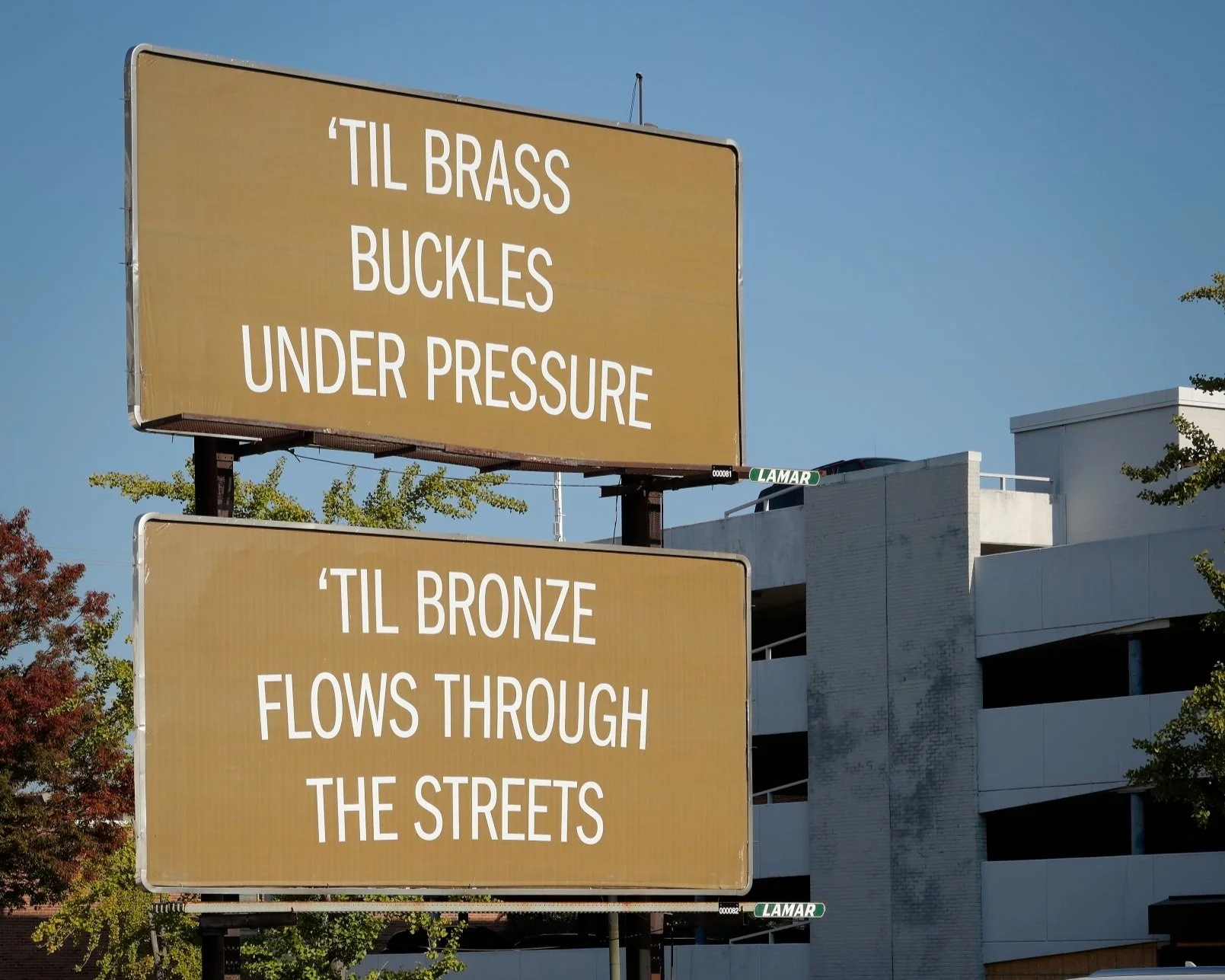TITLE: ‘til bronze flows through the streets
ARTIST: Wilmer Wilson IV
LOCATION: Richmond, VA
DATE: 10.05.2020 - 12.20.2020
TEXT:
1708 commissioned ’til bronze flows through the streets, a multi-site public work by Wilmer Wilson IV. This project destabilizes advertising platforms and systems of public communication through text, image, and performance documentation to pursue issues surrounding historical monuments, economic inequality, activism, propaganda, policing, and racial injustice. ’til bronze flows through the streets prioritizes metal as matter and metaphor, and expounds upon the binary logic of visible and non-visible political activity. Three billboard works are located at specific sites in Richmond, Virginia.
Across the U.S., the persistent presence of bronze Confederate monuments has been a flashpoint of numerous social and political movements. The state responses to uprisings concerning these contentious markers of historical, racial injustices are often noncommittal and obfuscate self-interests of city and state administrations. Wilson proposes that the actions surrounding the recent taking down of these monuments fall short of addressing the material inequalities that hinder meaningful structural change in society. While these removals are highly visible, the way they occur establishes a non-visible maintenance of continued existence, and by extension a continued status quo of systemic racism. Wilson’s billboards turn toward metallic infrastructural materials—specifically bronze and brass—as a starting point for thinking beyond a conciliatory politics of display and removal in our public discourse, as well as for re-thinking the terms of how societal change might be brought about.
’til bronze flows through the streets challenges social complacency sustained by neoliberalism in a call for a more rigorous analysis of ideological language and mechanisms of communication. This project draws from the activities of the artistic and activist group the Situationist International (SI). From 1957-1972 the SI sought to re-contextualize sites of mass spectacle—be it in capitalist or political manifestations of advertising and propaganda—in order to expose and redirect the systems of spectacle itself. One means of this action—détournement—occurs in Wilson’s project, and as Guy Debord and Gil J. Wolman elaborate:
“...in our view the premises for revolution, on the cultural as well as the strictly political level, are not only ripe, they have begun to rot...The mutual interference of two worlds of feeling, or the juxtaposition of two independent expressions, supersedes the original elements and produces a synthetic organization of greater efficacy...Détournement not only leads to the discovery of new aspects of talent; in addition, clashing head-on with all social and legal conventions, it cannot fail to be a powerful cultural weapon in the service of a real class struggle.” [1]
’til bronze flows through the streets recognizes billboards as quasi-public spaces of circulation and exchange, and reorients their advertising logic through tactical moments of ambiguity. In two billboards located on West Grace Street directly across from the Richmond Police Department headquarters, text compositions reference protest sloganeering while embedded in a number of design standards drawn from advertising, U.S. currency, and competitive awards. As text, the two phrases prompt viewers to visualize imagery that registers their own matrix of political and cultural associations. This highly charged billboard location and its direct texts are linked to a third image-based billboard, located next to a frequented bus stop near a bustling entry to the Church Hill neighborhood. The visceral image of molten metal pouring onto the sidewalk is a performance record and respectful remembrance to Wilson’s family history, and the history of prosperity of Black people and communities in Richmond. The site of the pour occurred in front of a former business run by a member of Wilson’s family in the Jackson Ward neighborhood—a historic epicenter of Black economy and Black life.
The entirety of ’til bronze flows through the streets proposes, through a hijacking of both the logic of public political gestures and advertising, a need for new forms that can hold the complexities of shared histories and political praxis. Citing bronze and brass as core components to the catalyzing of activist movements, these pronouncements and images point to many structural intersections inherent to mechanisms of racial injustice and inequality. This commission is on view throughout the 2020 election season, and positions public art as means of encouragement for civic participation.
[1] Debord, Guy, and Gil J. Wolman. “A User’s Guide to Detournement.” A User’s Guide to Detournement (Guy Debord & Gil Wolman). Bureau of Public Secrets, n.d. http://www.bopsecrets.org/SI/detourn.htm. “Mode d’emploi du détournement” originally appeared in the Belgian surrealist journal Les Lèvres Nues #8 (May 1956). This translation by Ken Knabb is from the Situationist International Anthology (Revised and Expanded Edition, 2006). 
